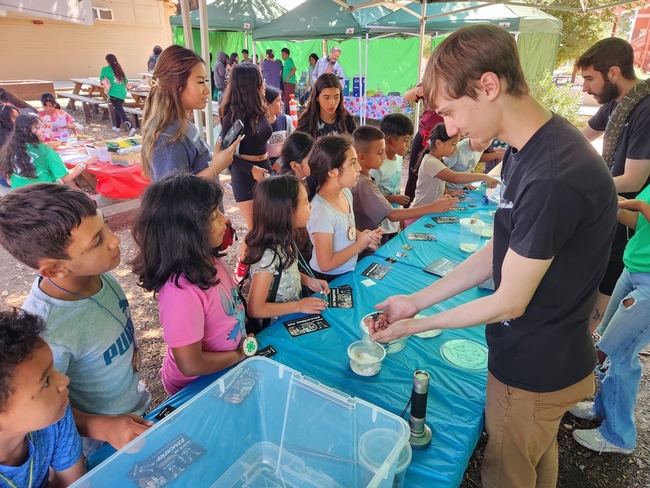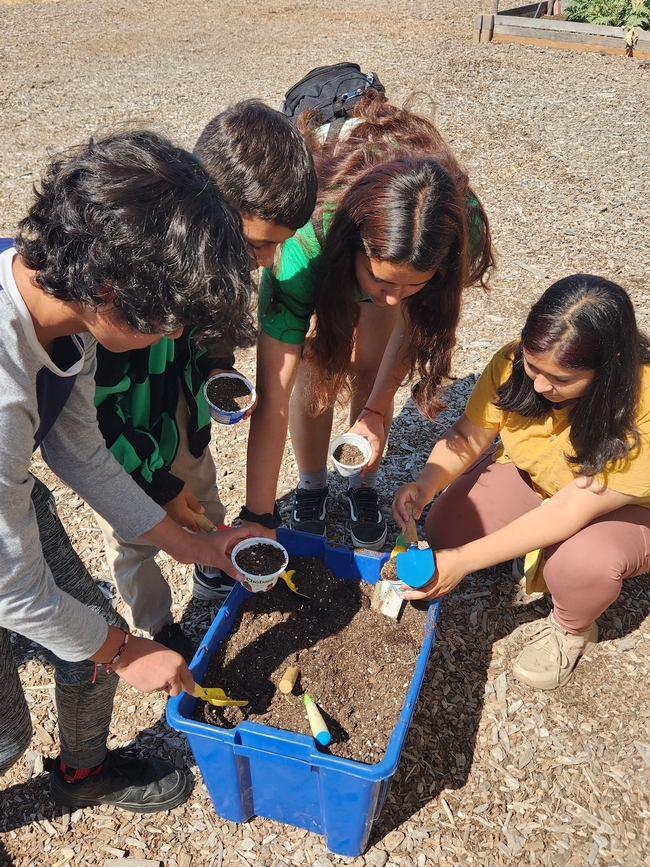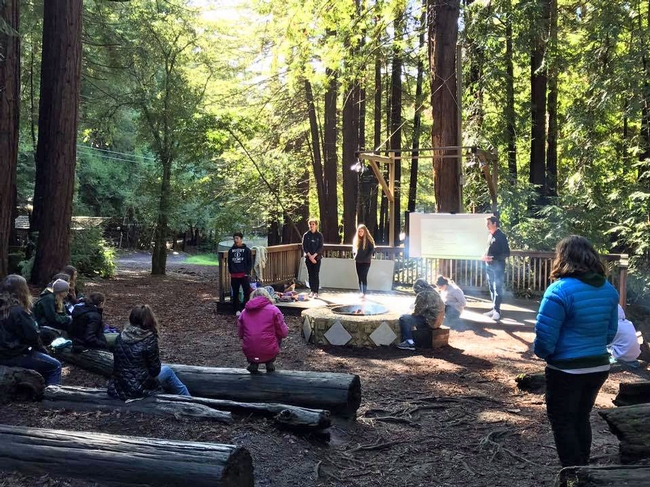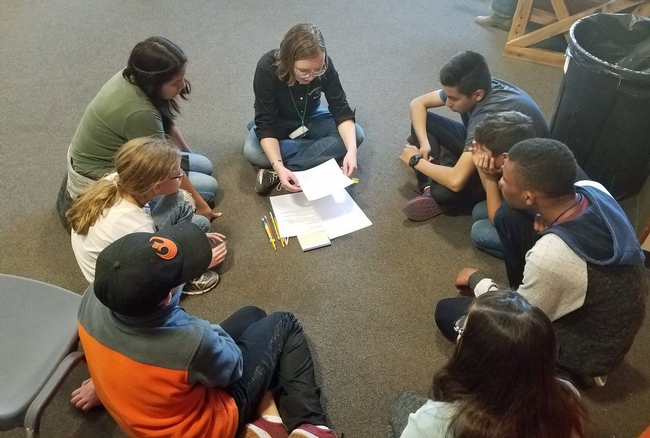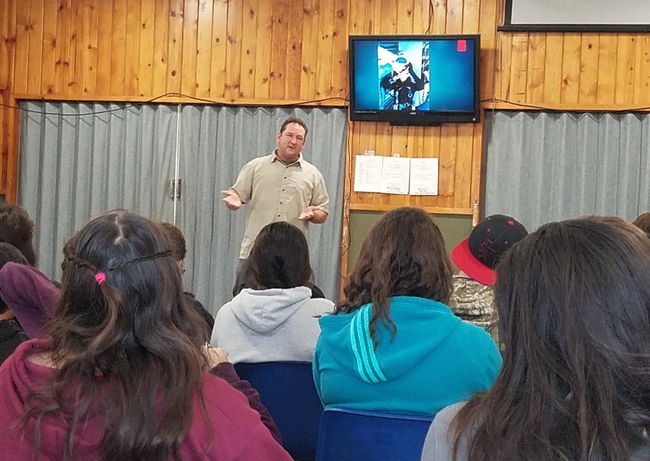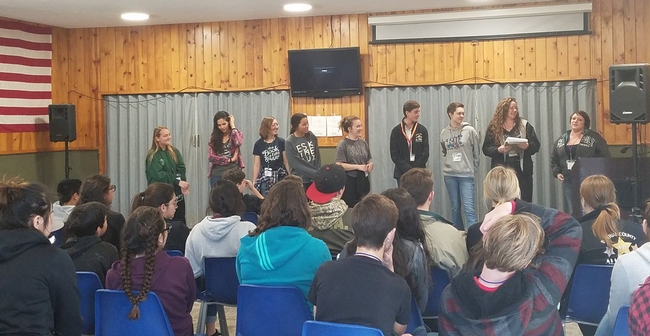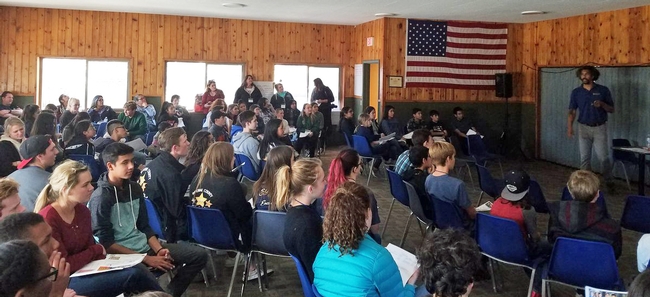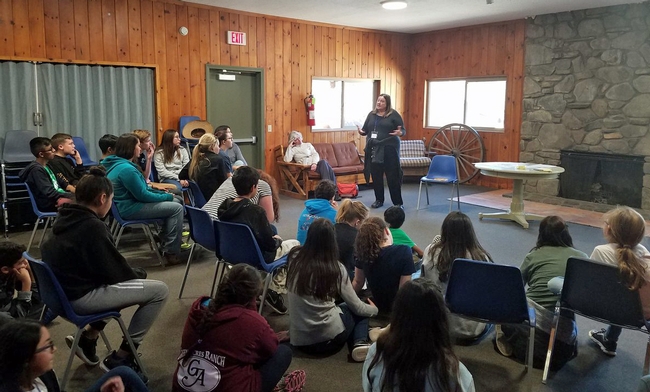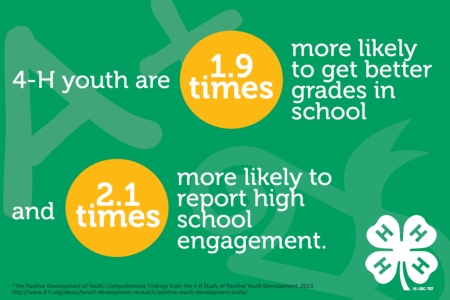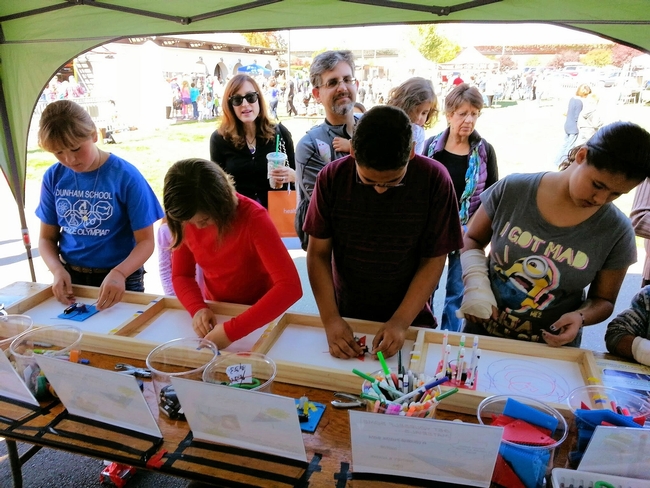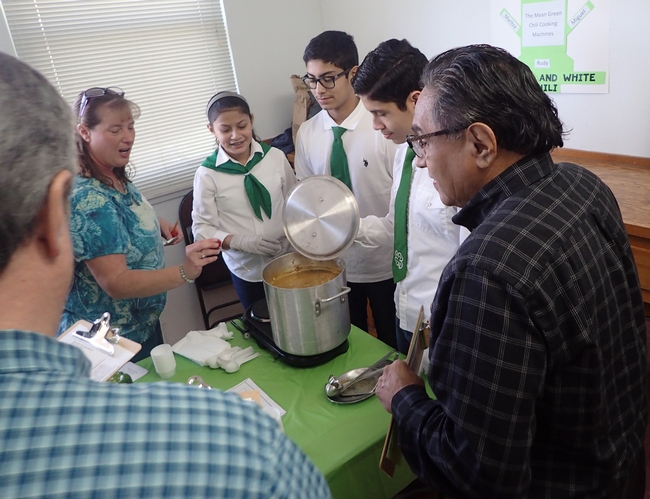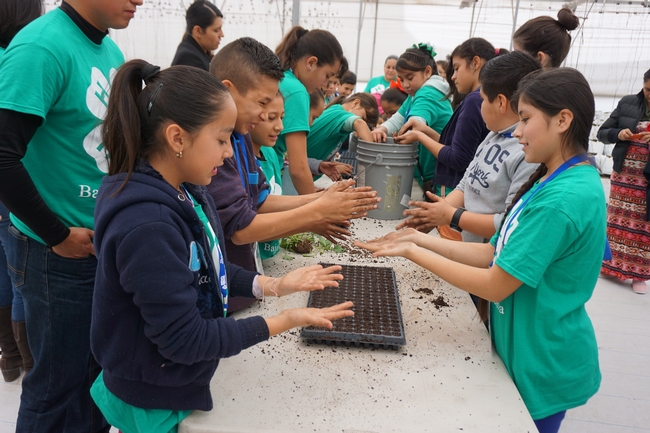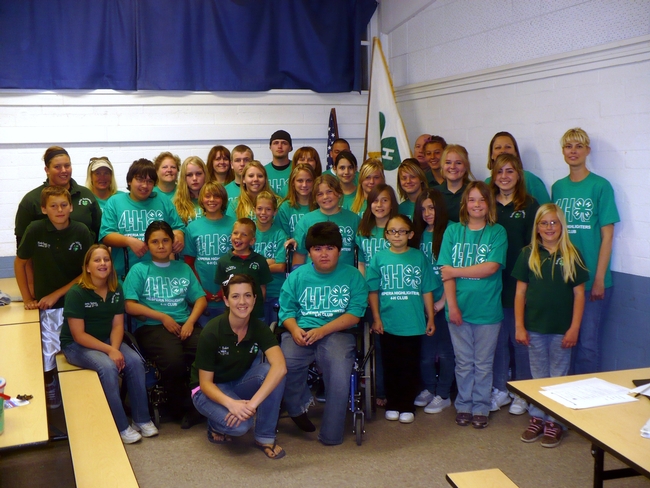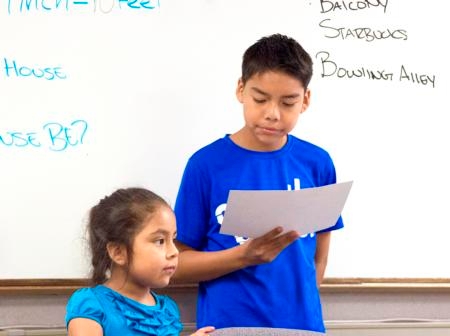Posts Tagged: Latino
Latino students shine (and squeal) at 4-H Nature Explorers Day Camp
University of California Cooperative Extension, 4-H Youth Development Program in Santa Clara County partnered with multiple community organizations to hold a 4-H Nature Explorers Day Camp at Escuela Popular Bilingual Academy in East San Jose from July 17 to July 21.
Organizers wanted to reach more participants this year than they had in the inaugural 2022 camp, so they structured the program for different K-8 grade levels to attend on different days. 79 campers participated, which was a 130% increase over the number of campers last year.
“Everything we did during the week was focused on environmental science,” said Susan Weaver, 4-H Regional Program Coordinator. “We partnered with Project Learning Tree, UC Environmental Stewards, UC Master Gardeners and CalFresh Healthy Living, UC– as well as community agencies related to the natural environment.”
Numerous activities engaged the youths such as field trips; demonstrations; and sessions themed around trees as habitats, birds and bugs, and being “leaf detectives.” 4-H Adult Volunteer, Laura Tiscareno, took charge of the hands-on Project Learning Tree sessions. Craft time included making nature-themed wind chimes and spinning paper snakes.
Bilingual teen camp counselors guided small groups of students for the duration of the day camp. In situations where the adult facilitator did not speak Spanish, teens translated information into Spanish for students with less English confidence.
“These kids call me ‘teacher' and it's awesome,” said Rodrigo, one of the counselors. “The camp benefits me a lot because I connect with children and in the future, I can even be a teacher if I wanted to.”
Another counselor, Andrea, learned about communication. “It's a bit different with kids at different age levels,” she said. “Since we had kindergarten through eighth grade, we had to switch our tactics from grade to grade so that they would understand us and we'd be able to understand them. Also learning how to bond with them so that they would pay more attention.
One highlight of the week was a field trip for third through eighth graders to the Master Gardeners location at Martial Cottle Park, where students learned about vermicomposting and made their own individual countertop worm habitat and composter.
Campers especially enjoyed the interactive demonstrations. “My favorite part is going on all the field trips because we went to a garden, and we've been catching worms and doing stuff about worms,” said one student. “It's really fun going on trips.”
Another camper said, “Something I would like to change about camp is having more time here.”
The program culminated in a Nature Camp Festival at Escuela Popular in partnership with community agencies. Youth enjoyed games, meeting reptiles, outdoor science activities, arborist crafts, a “Rethink Your Drink” table to make a fresh fruit drink, tamales, a nacho bar and more.
Representatives from the Silicon Valley Wildlife Center discussed animals that live in local neighborhoods and how the Center supports people to keep the animals safe. Victor Mortari of Vexotic Me talked about and showed snakes, spiders, scorpions, and other creatures, making the kids squeal while learning about them. As a fun added bonus, 4-H Community Educator Zubia Mahmood arranged to have a local team come to teach soccer skills as a healthy living activity.
The event increased the youth's interest in environmental education and involved Latino youth and adults who are new to 4-H – representing a community that has not historically benefited from the 4-H program. The teen teachers also increased their leadership and career readiness skills; post-camp surveys showed that all the teen counselors see 4-H as a place where they can be a leader and help make group decisions. Some campers noted in the survey that they wanted the camp to be every day, all summer!
National 4-H funded the camp in 2022 and 2023, allowing organizers to provide meals, T-shirts, water bottles and other items to foster belonging and promote healthy living. Community partners, crucial to the program's success, included the Boys and Girls Club of Silicon Valley, Escuela Popular Bilingual Academy, Silicon Valley Water and Silicon Valley Wildlife Center.

Teen counselors and campers working on a nutrition activity.
Latino youths increase their presence in UC ANR 4-H program
For more than 200 youngsters in California, including 45 Latinos, the last weekend of January was a unique experience, full of physical activities and workshops that will help them build a successful future. Under the theme “Be a leader, Be a hero,” they participated in the 4-H Youth Summit carried out in several California counties. The event showcased the efforts of UC Agriculture and Natural Resources to increase the participation of young Latinos in its 4-H Youth Development Program.
“We are very excited that for the first time 45 Latino youths participated in the Youth Summit,” said Lupita Fabregas, 4-H assistant director for diversity and expansion.
The participating youths, ages 11 to 19, enjoyed hiking and other outdoor activities at the various 4-H camps. Among the camps were Mountain Center, located in the San Jacinto Mountains in Riverside County; YMCA Camp Jones Gulch in La Honda, located in the Santa Cruz mountains in San Mateo County; and Wonder Valley Ranch in Sanger, located in Sierra Nevada Mountains in Fresno County.
The adolescents had the opportunity to learn skills to help them develop their potential in addition to other topics of interest.
“Participants also had the opportunity to learn about engineering design process and the importance of bees to the environment,” said Claudia Diaz-Carrasco, 4-H advisor in San Bernardino and Riverside counties.
The increase of Latino youth in these 4-H camps, is the result of an initiative that has been implemented within the last couple of years.
Seven California counties including Kern, Riverside, Merced, Monterey, Orange, Santa Barbara and Sonoma were selected to participate in a pilot model to increase the number of young Latinos participating in the 4-H program.
The model was designed to ensure that young people living in urban areas could receive the same benefits as those who have participated in 4-H since it was founded in 1902 in Ohio.
“The original goal was that young men and women learned leadership skills through interaction with farm animals and food conservation,” added Fabregas.
For the 21st century, 4-H has designed new methods for young people in rural communities, urban and suburban areas based on the same original principles – offering leadership skills to its participants.
"The 4-H participants learn about issues of global importance such as food security, climate change and sustainable energy. It also teaches them about other issues, such as childhood obesity, and basic finance," said Diaz-Carrasco, who has seen a considerable increase of Latino participants in the 4-H programs in the Inland Empire.
“It was hard, we had many challenges,” said Diaz-Carrasco, who works in a county that is 50 percent urban and its young population is almost 59 percent Latino. Lack of transportation, time and money were the biggest threats to the success of the pilot model.
In 2016, Diaz-Carrasco was selected to participate in UC ANR's Latino initiative, under the direction of Lupita Fabregas. The first step taken was to hire the first bilingual educator of the 4-H program and establish the first bilingual club in a community center in a heavily Latino populated part of the city of Riverside.
"These new models have had an impact on the program in the seven pilot counties," said Fabregas. Two years later, there are three bilingual clubs in the county.
The response from the Latino youth has exceeded expectations. In 2015, the California 4-H program worked with less than 1 percent of children in the state. By 2017, participation in the program grew 16 percent and the participation of Latino children increased 89 percent.
Parents of these young Latinos participating in the 4-H program are seeing positive changes in their kids. According to the parents, 4-H gives their kids an opportunity for social and personal interaction. “It enables young people to understand who they are and prepares them to choose what they are going to do with their life as adults,” said Sergio Sierra, whose children are participating in the 4-H program in Indio, California.
Studies have shown that young people participating in the 4-H program are 1.9 times more likely to get better grades in school and 2.1 times more likely to report being engaged in school activities.
California leads the country with more participants in the 4-H Latino Initiative than other states. In spite of the gains achieved, there is still more outreach to be done, Fabregas said.
More Latinos are joining 4-H, according to initial UC ANR outreach report
Latino youth participation in 4-H is on the rise, according to a report on the first year of UC Agriculture and Natural Resources' three-year 4-H Latino Initiative.
Increasing Latino participation in 4-H has been a priority for some time. Over the last five years, participation in 4-H increased 41 percent; Latino participation increased 173 percent. While growing, the fraction of 4-H members who are Latino still falls below their proportion of the state's population.
“We're just getting started in implementing a new statewide comprehensive plan to reach Latino youth,” said Lupita Fabregas, assistant director for 4-H diversity and expansion. “We know 4-H helps prepare kids for success in college and life. We're thrilled to be involving more Latinos.”
When 4-H was formed 100 years ago, it was an educational club for farm kids. Often seen in spotless white and kelly green garments, participants raised animals, gardened, cooked and sewed while learning leadership and public speaking skills. In the latter half of the 20th century, when California became more urbanized, 4-H began adding education in broader program areas, such as rocketry, robotics, computer science and environmental stewardship.
California demographics were also changing. The state became more ethnically diverse. In 2014, Latinos surpassed whites as the largest ethnic group. But they weren't reaping the benefits of 4-H membership at the same rate.
UC Agriculture and Natural Resources (UC ANR) the 4-H parent organization in California, researched the reasons for low Latino 4-H membership, and realized there were opportunities to develop new program models and methods to reach minority populations without changing the 4-H core values.
“As an organization, we identified the values and core elements of 4-H that make us unique,” said Shannon Horrillo, UC ANR statewide 4-H director. “We decided that no matter how we adapted the program, we would not stray from those foundational elements.”
Core elements include youth leadership, youth-adult partnerships, life skills learning, community service and service learning, the 4-H Pledge, and well-known 4-H name and green four-leaf clover emblem. It became apparent that some of the requirements that were part of the community club tradition – such as the required meeting attendances, parliamentary procedures and officer structure – were barriers to extending the program to a more diverse population.
“We can be more flexible in how the program looks and in requirements while maintaining what has made 4-H an impactful program for more than 100 years,” Horrillo said.
New club models were launched, including special interest clubs (called SPIN clubs), in-school clubs and after-school clubs.
4-H membership began looking a lot more like the highly diverse citizenry in the state's densely populated cities. In 2016, UC ANR allocated funds to employ bilingual 4-H community education specialists in seven California counties for three years to further boost Latino participation. The specialists are making a concerted effort to reach out to Latino youth, parents, community leaders, schools, churches and other organizations to extend 4-H programming to wider and more diverse audiences in Kern, Merced, Monterey, Orange, Riverside, Santa Barbara and Sonoma counties.
“Our staff are making strides in adapting 4-H to be culturally relevant for Latino youth,” Fabregas said. “This work will help all youth feel welcome, appreciated and valued in 4-H programs.”
The new effort will include a fundraising program to maintain and expand the emphasis on Latino outreach after the current three-year funding period concludes. The UC ANR Development office is working with the 4-H Latino Initiative to develop a plan to combine local fundraising, grant awards, contracts with schools and agencies, and foundation and private gifts to keep the program going beyond the current three-year term.
“Though the progress to date has been significant, we know that we'll need to hire more community educators to strengthen our resources if we're going to bring 4-H to a great number of Latinos,” said Andrea Ambrose, UC ANR director of development.
4-H Youth Development team wins national diversity award
UC 4-H Youth Development advisors Dorina Espinoza, Russell Hill, Fe Moncloa and Keith Nathaniel and 4-H associate director Shannon Horrillo have won the National Extension Diversity Award for systematically enhancing the intercultural competency of 4-H personnel and others in California. The National Extension Diversity Award was presented Sunday, Nov. 13, at the 129th Association of Public and Land-grant Universities Annual Meeting in Austin, Texas.
The award, given by USDA National Institute of Food and Agriculture (NIFA), Cooperative Extension System and the APLU, honors the team for developing and institutionalizing a professional development strategy to increase staff and academics' intercultural competence.
To support the development and well-being of California's culturally and ethnically diverse youth population, research indicates that building intercultural competence among youth development professionals is critical.
“We have been making changes to our programs to remove barriers and make 4-H more accessible. We are also testing new delivery models to expand 4-H's reach, particularly among Latino youth and families,” Horrillo said.
“This effort has been extremely successful and we are seeing the benefits in our membership,” said Horrillo. “The program's growth over the last year was significant, with a 16 percent increase in youth participation and a nearly 42 percent increase in Latino youth participation.”
“We asked Latino parents how we can help,” said Lupita Fabregas, assistant director for 4-H Diversity and Expansion. “Working parents suggested after school programs so they don't have to drive their kids to a different location.”
Through a pilot initiative in seven counties – Riverside, Orange, Kern, Santa Barbara, Monterey, Merced and Sonoma counties – UC ANR's 4-H Youth Development Program now offers in-school, after school and special interest clubs that explore subjects such as robotics. Children can join clubs that focus on projects for four to six weeks, rather than 4-H's year-long commitment. Bilingual and bicultural program representatives provide materials in English for the children and Spanish for parents. Although the activities are structured differently, they aim to teach Latino children science, leadership, civic engagement and other life skills taught through the traditional program.
The team of change agents applied the professional development strategy over three years, providing 176 hours of intercultural communication feedback sessions, learning communities and regional conferences to enhance the intercultural competence of 65 California 4-H personnel.
The UC ANR 4-H Youth Development Program has also assembled an advisory committee for 4-H multicultural and community engagement that includes Latino leaders Mary Lou de Leon Siantz, a professor at the Betty Irene Moore School of Nursing at UC Davis and director of the Center for Advancing Multicultural Perspectives on Science (CAMPOS); Steven Olmos, chief schools officer for Santa Clara County Office of Education; Albert Maldonado Jr., youth program manager for The California Endowment; and Juan P. Garcia, deputy director of the California Hispanic Chambers of Commerce.
UC ANR's action plan and resulting positive change provides a model for 4-H in other states to improve professional development and expand the program's reach. A summary of California's IDI professional development activities can be found in the National 4-H Latino Youth Outreach: Best Practices Toolkit, Professional Development.
Simple ways to make Latino food more nutritious
In the United States, Latinos account for 15 percent of the population, more than 47 million in all, but you can’t paint their impact on U.S. culture with a broad brush – especially when it comes to food. The Latino population is culturally and ethnically diverse.
Differences between Mexico, Puerto Rico and other Latin American countries stem from 500 years of separate histories, diverse native populations and their customs prior to the arrival of Spanish explorers. In order for nutrition educators to help Latinos maintain a healthy diet, messages should be tailored specifically to the Latino population residing in the particular geographical area.
In California, more than 80 percent of the Latino population is of Mexican descent. The Mexican diet is a blend of pre-Columbian, indigenous Indian, Spanish, French, and recently, American culture. Typically, the Mexican diet is rich in complex carbohydrates, which are provided mainly by corn and corn products, usually tortillas, present at almost every meal, beans, rice and breads. The diet also contains protein from beans, eggs, fish and shellfish, and a variety of meats, mostly pork and poultry. Traditional diets also reflect the geographic regions of Mexico and the availability of local fruits, vegetables, grains and dairy products.
There are simple ways to make traditional Mexican dishes healthier. Following are seven suggestions based on the 2010 American Dietary Guidelines:
- Substitute refried beans with whole black beans or pinto beans. Serve boiled beans instead of refrying them. For flavor, add spices like laurel leaves and other traditional spices.
- For refried beans, substitute lard, butter and shortening with olive oil or vegetable oil. These oils are free of trans fats and contain unsaturated fats, which help prevent cardiovascular disease by inhibiting the buildup of cholesterol in the body.
- Bake your own chips and use whole wheat tortillas to make them crispy and flavorful. This will reduce fat and calorie content.
- Grill or bake instead of frying to reduce the amount of oil you will ingest.
- For toppings, use plain yogurt instead of sour cream. There are some yogurts with the same consistency as sour cream. Add some chipotle, green onion and black olives to give flavor and make it attractive.
- Eat guacamole. Avocado (traditionally known as aguacate or palta) is cholesterol-free and potassium-packed.
- Use more spices – like cumin, peppers, paprika, chili sauces, garlic, cilantro and parsley – instead of salt. Keep salt consumption to less than one teaspoon per day. High salt consumption is linked to increased risk of high blood pressure and kidney disease.
The use of sugar and other caloric sweeteners – such as honey and high-fructose corn syrup – should also be minimized. They contribute to an increased risk of chronic disease, such as cardiovascular diseases and diabetes. The consumption of sugary sodas is very common in the Latino community. Some changes to reduce sugar consumption include:
- Drink water instead of sodas. Add flavor to water by adding mint, parsley, cucumber or lemon slices.
- Drink more aguas frescas; use fruits like pineapple, watermelon, melon, guava, mango. Add some cinnamon for flavor and to reduce the amount of sugar.
- Children should eat cereal without added sugar. Instead they can eat hot cereal and add seasonal fruit like apples, peaches or strawberries.
- Prepare fruits as dessert. Bake apples, serve bananas sprinkled with cinnamon and walnuts, watermelon with chili and lemon, and papaya with lemon.
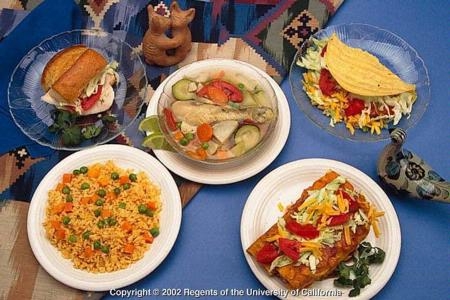
Examples of traditional Mexican food.

